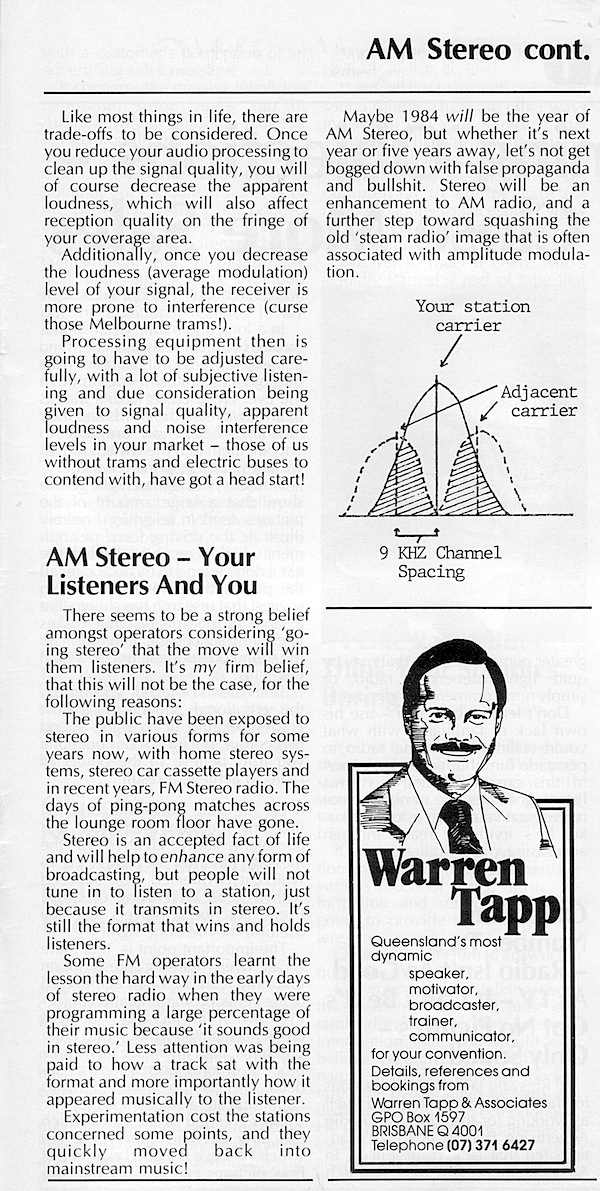The 1st February is 30 years since the introduction of AM Stereo.
Over the next few days, a collection of radioinfo experts will look back on the technology and the lessons the radio industry learnt from it, and, with the help of Jose Auditore and the Radio Green Room team, we will revisit the highs and lows of the time that the technology was introduced.
When FM came to Australia, the stereo separation, the clarity of sound and the new formats it spawned led to a decline in audience for stations on the once dominant AM band.
AM Stereo was hailed by some as the way that AM could fight back. It was not, and eventually it died out.
It was not just stereo that seduced audiences – FM technology had a wider range of frequencies and sounded brighter than the ‘muddy’ sound of AM, and, more significantly, the new formats on FM introduced music formatting and announcing styles that had never been heard in Australia before.

In 1983 when some AM broadcasters commenced converting to AM Stereo, I was writing a column for Pulse Magazine (run by Mike Wass).
This was prompted after I attended a presentation organised by “AM Stereo Australia” a committee within FARB, made up of mainly metro AM Managers. They travelled to all major markets doing presentations to encourage stations to take up AM Stereo.
At the presentation I attended in Adelaide the speaker said “ AM Stereo will sound as good – if not better than FM.” I took great offence to this (as the then Chief Engineer of SAFM), as technically that statement was just not possible to achieve. Hence the article in Pulse (click to enlarge).
In the article, in the section on audio processing you will read that it was necessary to reduce modulation levels or loudness of the station in order to accommodate the AM Stereo signal.
Given the extremely poor situation with receiver availability many stations were reluctant to sacrifice loudness and move to AM Stereo knowing that there were only a handful of receivers in the market. Some metro’s never made the move.
Loudness wa s big thing particularly for AM – to combat high levels of manmade noise – as well as jumping out of the radio compared to the competition!
Further exasperation came from the Australian Government approving all 4 AM Stereo Systems that were available. Sony had one of the few receivers on the market (pictured above) which would decode all 4 systems – provided you knew which system you were listening to and selected it on a switch on the bottom of the radio!
It was the Motorola CQUAM AM Stereo System that was most popular, so receivers that could not decode that system didn’t get into the market, therefore the range of receivers was limited.
One broadcaster was going to import some 2,200 receivers as a start up for the whole of Australia!
I have also attached an ad from Pulse (above) indicating which metro stations had adopted AM Stereo as of Nov 1983.
The Harris agency was with 2SM in those days and they spent a lot of time pushing AM Stereo.
I don’t believe anyone is broadcasting in AM Stereo in Australia today as there just aren’t any receivers around. Wikipedia claims that 2CA and 2CC are broadcasting in AM stereo but I doubt this is correct. Austereo owned 2CA and FM104.7 in the 80’s and CA certainly was not broadcasting stereo then. I doubt very much that Kevin Blyton would be broadcasting stereo on CA and CC today – there is no point in it.



